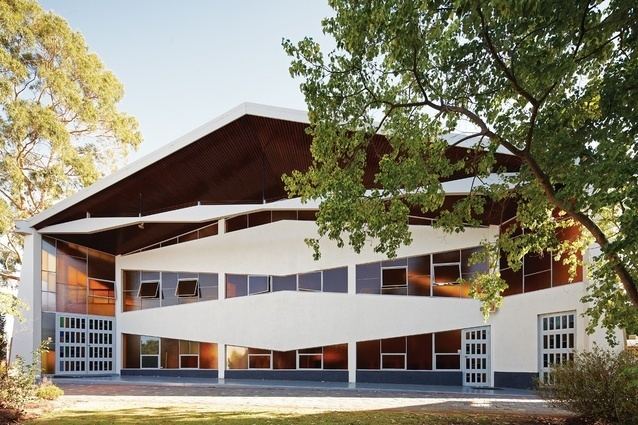Name Raymond Jones Role Architect | ||
 | ||
Raymond jones making love ueg 1999
Raymond Alfredo Daniel Jones (born 18 July 1925) is an Australian Modernist architect. His work includes many building types, including residential, ecclesiastical, educational, commercial, and prefabricated kit buildings.
Contents
- Raymond jones making love ueg 1999
- History
- Contribution
- Current thoughts on architecture
- Notable projects
- References

Like his mentor Robin Boyd, Jones has continued to experiment with ideas of space and environmental design. His architectural works promote passive environmental systems, and has become a leader in the implementation of sustainable design practices in Western Australia.
History
Raymond Jones was born in Geelong, Victoria, Australia on 18 July 1925.
From 1943 to 1945, Jones joined the Royal Australian Navy, and was aboard the cruiser HMAS Australia during the Philippines Campaign.
In 1946, Jones began his architectural studies at the University of Melbourne, and was taught by Robin Boyd, Roy Grounds, John Mockridge, and Frederick Romberg. Jones took a particular interest in the works of Boyd, particularly in relation to Boyd's ideas of spatial continuity between building and landscape, as well as his environmental design philosophy.
Upon completion of his architectural degree in 1951, Jones worked for Melbourne architectural firm, Yuncken, Freeman Brothers, Griffiths & Simpson (now known as Yuncken Freeman). At the same time, Jones became part of the design team that won a competition to design an Olympic stadium in Carlton, Victoria, as well as housing for the new town of Eildon, Victoria, which had been constructed to support the construction of Lake Eildon.
During his studies, Jones played Australian rules football for Collingwood and Melbourne from 1946 to 1949. In 1953, he later played in a premiership with the South Fremantle Football Club.
Jones moved to Western Australia in 1953 and began his own practice in Perth. During the 1950s Jones had an increased number of staff, ranging from young architects and students, which included; Wallace Greenham, Walter Hunter, Robert Hart, Ken Yewers, and Michael Patroni.
From 1966 to 1967, Jones had practiced in partnership with Montague Grant, going by the name "Jones Grant Architects".
His first significant architectural project was his own residence, the 'Jones House', in Haining Avenue, Cottesloe, where Jones heavily references the architectural teachings of Boyd Jones begins to experiment with space and structure in responding to the environment, through passive ventilation, northern glazing and thermal massing
Jones is also noted for his many ecclesiastical projects, and completed a total of six churches for the Catholic Church. All of his churches were inspired by cave-like catacombs, a common metaphor he used in the design of communal spaces. The Church of St Cecilia, in Kenmore Crescent Floreat, references this cave-like metaphor, and departs from the typical cruciform plan. Instead, St. Cecilia's pentagonal form was based on a total of ten planes (five walls planes and five roof planes), which symbolised the Ten Commandments and the sacrifice of Jesus Christ.
Jones' educational projects, particularly his work at Preschool Centre in Stirling Highway, North Fremantle; New Day Nursery in High Street/Parry Street, Fremantle; and 'Winterfold Primary School', in Annie Street, Hamilton Hill, have been designed to enable variable use, through the use of large internal and external centralised spaces.
This relationship between space and environmental design culminates in his development of the Tetrakit system. Working in the cyclonic areas of north-western Australia in the aftermath of Cyclone Tracy in 1974, Jones with the help of structural engineer George Katieva, devised prefabricated kit homes. Constructed of prefabricated frames and panels, the Tetrakit kit home would resist the strong wind pressures during a cyclone. Roofs and walls inclined at 15 degrees balanced the cyclonic winds loads placed on the building.
Contribution
His interests and passions in ecological design continued, particularly through the use of skillion roofing and courtyard spaces, as well as passive ventilation and site orientation, as environmental design strategies. Jones is also attributed to the innovative use of concrete raft slabs and swimming pools to suburban housing, in controlling interior temperatures. Climate also begun to inform Jones' approach to architecture, experimenting with how architecture is best suited to its particular site and environment.
Current thoughts on architecture
Jones has been a lifelong critic of active heating and cooling systems, particularly mechanical air conditioning, and always strived to create buildings which rely on more passive systems. He states that, "We ought to legislate that there is no air-conditioning in new homes and that a building license should only be issued if they build along renewable energy principles. You can do it well without building expensively".
Jones is not impressed by a lot of modern architecture in Perth, saying he's depressed by the "proliferation of ugliness". "We are just not going forward at all, we are going backward". He blames Perth's ugly, impractical and unsustainable modern homes on the laziness and expediency of politicians, city planners and mass-marketed project homes. Mr Jones says he is a crusader for sensible, environmentally aware design.
Jones is still practicing as an architect as of 2011 and has no interest in quitting entirely any time soon, instead focusing on projects of interest.
